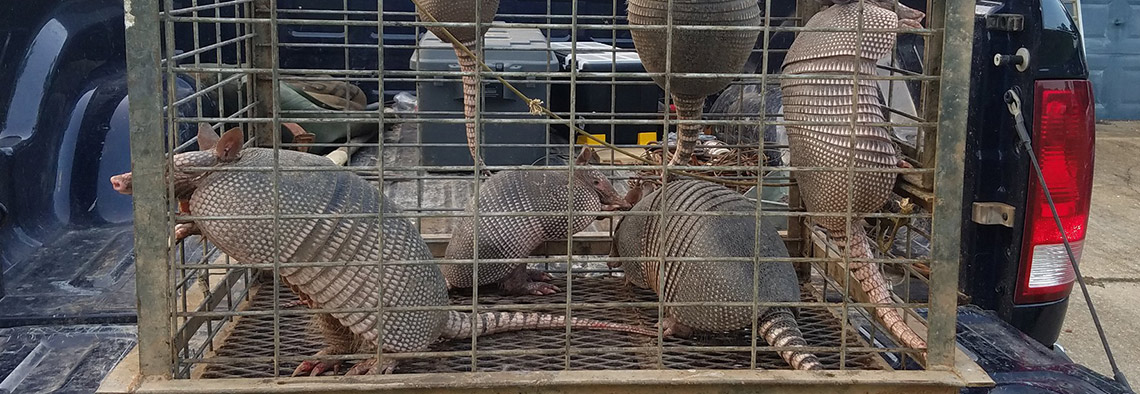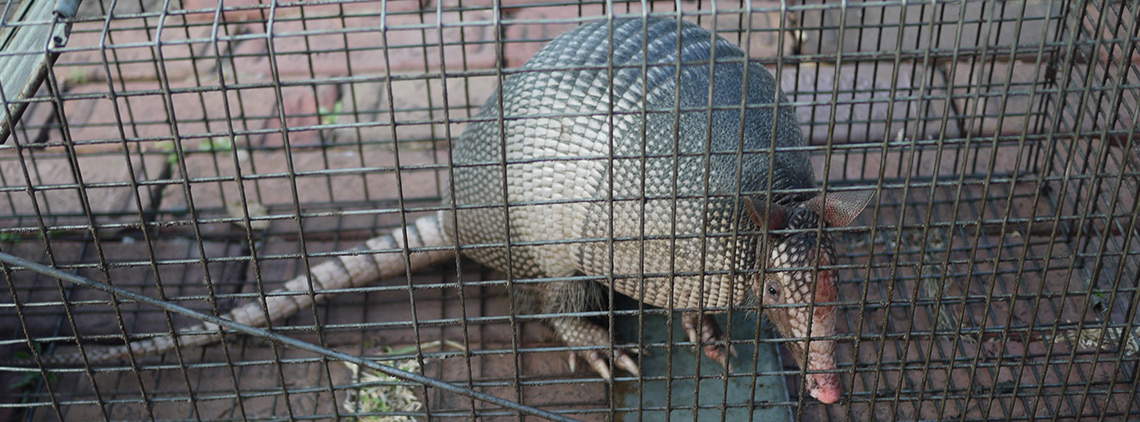Armadillo Removal - How to Get Rid of Armadillos
Armadillos - Problems They Cause, Methods of Removal and Prevention: The nine-banded long-nosed armadillo that lives in America is the most widespread armadillo. And from a total of twenty dillo species, only the nine-banded one lives in the US. This very interesting tatu specimen from the Dasypus family will produce a litter of four genetically identical cubs, all resulting from one single original egg. Armadillos are the only mammals that present such peculiar reproductive behavior. The genetically identical babies are great tools as test subjects in various areas of scientific research. Nonetheless, if being interesting and particular would automatically make you a non-problematic animal, there would be no need for my profession to exist, and armadillos are not the exception to the rule. I would say that the armadillo is the least smart of all nuisance animals a wildlife remover deals with on a regular basis, but that doesn't mean that they can't cause problems for homeowner and landowners, or that they don't deserve to be treated with respect and removed in a humane manner.

Problems caused by armadillos
The dillo is a nocturnal animal that feeds on grubs, earthworms and insects. This means it will start digging wherever it smells something good that lies underneath the ground, and get to licking up its food by rooting its long nose in the freshly dug hole. They will also make underground burrows for basic living and for raising their offspring. In addition to their denning burrow, they will also dig up strategic shallow holes nearby in case of emergency situations where they would need to run and hide. What this implies in terms of nuisance wildlife behavior is that if they start going on about their business on your lawn, they will destroy it in no time. On top of that, all their digging can produce structural collapse if they happen to make burrows under the house foundation. They can also cause problems with decks, concrete walkways, sidewalks, and even compromise AC units or fuel tanks by digging underneath such structures and objects.
Another problem with armadillos is that they are common roadkill, especially in the US South. Road mortality is not alarming in terms of armadillo population, but as they're pretty hefty animals, they often cause damage to the cars they collide with. Of course, armadillo carcasses all over the road represent a health hazard. Moreover, there are a number of people who enjoy eating roadkill, or are forced by circumstances to eat roadkill, and this is an even bigger health hazard as humans can contract leprosy from eating infected armadillos. Yes, that's another issue, the dillo carries and can transmit leprosy to human beings. This aspect is not entirely bad, because armadillos have helped a lot in the study of leprosy, and are still used for studying this infective disease.
Methods of removal and prevention
The only efficient way to remove armadillo is through live trapping. The same live cage trap you would use to remove a raccoon will also be effective for an armadillo. As with all invasive wildlife matters, it's all in the specific behaviors of the animal. Trap setting is essential, and you must be able to correctly identify the pathways used by the animal to circulate from burrow to burrow. Armadillos will usually have around thirty burrows in the space they inhabit, the majority of them shallow holes for escaping. Bait is not the way to go with capturing armadillos, so you will need to place the cage just right on one of the circulated pathways. There's a lot that goes into this tactic, and beginner trappers often find themselves at a dead-end after multiple failed attempts of encaging this scaled troublemaker. Knowledge and experience is key, as it always is when it comes to wildlife removal.
In terms of prevention, there's not a whole lot that you can do. Pouring cement all over your lawn just to keep armadillos out would be rather insane, and it's not like you can control the insect and worm population that lives in your soil. Well, you could try and eliminate the food source with parasitic worms. However, if successful, the dillo will just move one house over and become your neighbor's problem. What you could do would be to install a fence surrounding the area that's deep enough so that armadillos can't dig their way through. In fact, this is the only prevention method that will work in what concerns armadillo control.
Nuisance wildlife management is a complex business, and it takes years for a wildlife remover to bring his or hers methods and tactics to perfection. But once they do, it will be just a matter of quickly analyzing an area for them to know which tactics to use, and how to use it in order to achieve a perfect job in a short period of time. So, if you want a good job done quickly when dealing with armadillos, an experienced wildlife removal expert will always be your first answer.


Armadillo Removal - How to Get Rid of Armadillos
Can armadillos transmit leprosy to people?
Are armadillos dangerous to cats, dogs, or other pets?
What are some of the symptoms of a sick armadillo?
What is an armadillo's mating habits, when do they have babies, how do they raise their young?
What are some problems caused by armadillo digging?
About Armadillos: Appearance, Biology, Life Cycle, Habitat, Diet, behaviors
How Do You Know If You Have Armadillo under Your Shed or Porch
Do mothballs or ammonia help repel armadillos?
How to get armadillos out from under a shed or porch
Will a high pitch sound deterrent machine work against armadillos?
How to keep armadillos away from your property
Will repellents get a armadillo out of the shed or porch?
What equipment is needed to trap an Armadillo
What is the best bait to trap an Armadillo?
Is it legal for me to trap an Armadillo?
What should I do with an Armadillo after I catch it?
Where should I relocate a trapped armadillo?
What are some humane ways to kill a armadillo in a cage?
What are some ways to kill an armadillo in the yard?
Should I ever poison an armadillo?
What should I do if I find a nest of baby armadillos?
What do wildlife rehabilitators do with armadillos?
Do armadillos make good pets?
What diseases do armadillos carry?
Where do armadillos live? Do more armadillos live in urban areas, or wild areas?
What is an armadillo's natural diet, and how does it get its food?
How to keep armadillos out of my yard
Should I hire a pro, or remove armadillos myself?
Will the city or county animal services help me with a armadillo issue?
Will a pest control company remove a armadillo
How to use one-way exclusion funnels to remove armadillos without trapping them
Why do armadillos dig?
How did armadillos get into North America?
Describe armadillo skin/armor, and how it helps the animal

